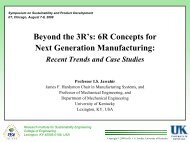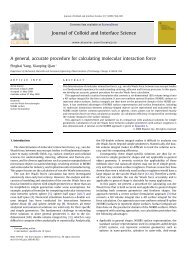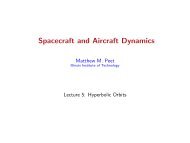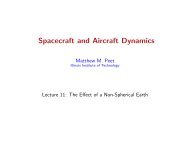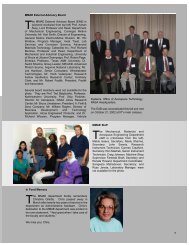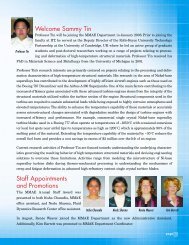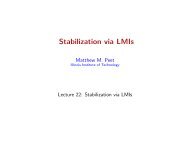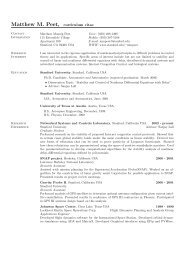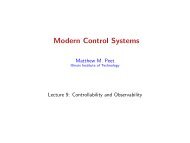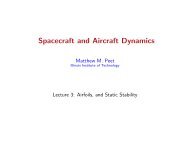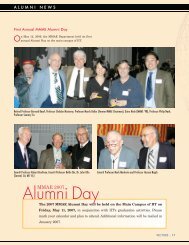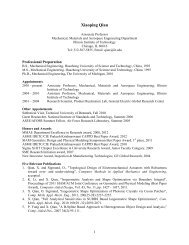Feature-based design for heterogeneous objects - Mechanical ...
Feature-based design for heterogeneous objects - Mechanical ...
Feature-based design for heterogeneous objects - Mechanical ...
You also want an ePaper? Increase the reach of your titles
YUMPU automatically turns print PDFs into web optimized ePapers that Google loves.
X. Qian, D. Dutta / Computer-Aided Design 36 (2004) 1263–1278 1269processes involving different materials. The three featuresprovide a generic tool <strong>for</strong> <strong>heterogeneous</strong> object modeling.Many existing <strong>design</strong>/fabrication automation tools <strong>for</strong><strong>heterogeneous</strong> <strong>objects</strong> processing are dedicated tools andthey can be directly derived from these three synthesizedfeatures. For example, the feature operation semantics usedin <strong>design</strong> by composition <strong>for</strong> layered manufacturing [3] andMEMS fabrication process simulation [5] can all be derivedfrom the synthesized features [20].Based on these synthesized feature operations, a feature<strong>based</strong> <strong>design</strong> methodology has been developed <strong>for</strong> <strong>heterogeneous</strong>object <strong>design</strong> [20]. In our implementation, weadopted the R-m set as the working representation scheme<strong>for</strong> <strong>heterogeneous</strong> <strong>objects</strong>, even though other representationschemes can also be used to represent the semantic featuresdefined above. That is, in our implementation, an R-m setðg; mÞ is used as the building block <strong>for</strong> the constructive<strong>design</strong>. A compound feature (building block), consisting ofmore than one R-m set, can also be defined, i.e. a finitecollection of R-m sets, ðg 1 ; m 1 Þ; ðg 2 ; m 2 Þ; …; ðg n ; m n Þ; eachconsisting of a material volume. To support a constructive<strong>design</strong> of <strong>heterogeneous</strong> <strong>objects</strong>, we extended the radialedgegraph to represent the geometry of <strong>heterogeneous</strong><strong>objects</strong> [24]. In this extended data structure, each region hasits material composition representation and each face usehas neighborhood in<strong>for</strong>mation, which contains a pointerpointing to material representation. Such a methodologyneeds two enabling component techniques: how to definematerial composition within each material volume and howto combine material volumes. These two enabling techniquesare presented in Sections 4 and 5.Fig. 7. Generic feature operations <strong>for</strong> <strong>heterogeneous</strong> <strong>objects</strong>.The partition feature functions the same as additivefeatures over the intersection region ðg 1 > g 2 Þ; but it is notapplicable to the region outside of g 1 : This partition featureis used extensively <strong>for</strong> <strong>heterogeneous</strong> object modeling whenmaterial functions are imposed on a given geometrydomain.These synthesized features support both <strong>for</strong>m feature andmaterial feature operations. It associates each materialvolume with one geometric/material operator. They precluderedundant definitions of the geometry in both <strong>for</strong>mfeatures and material features. The four types of relationshipsbetween the geometric volumes of <strong>for</strong>m features andmaterial features can be fully manifested by the synthesizedfeatures in a constructive approach. In this approach, thebuilding blocks are the synthesized features. The <strong>design</strong>erhas two choices: either use the default materials to model<strong>for</strong>m features and then partition the part volume withspecific material composition functions, or glue a set ofmaterial feature volumes.These synthesized feature operations can be used to<strong>design</strong> <strong>heterogeneous</strong> <strong>objects</strong> or simulate manufacturing4. Material heterogeneity modeling <strong>based</strong>on <strong>design</strong> intentIn order to use synthetic material features as a buildingblock <strong>for</strong> feature <strong>based</strong> <strong>design</strong>, we need a method to definematerial heterogeneity within each feature volume that canrepresent <strong>design</strong> intents. During the iterative <strong>design</strong> editingprocess, these <strong>design</strong> intents need to be preserved. In thissection, we present a method in which <strong>design</strong>er specifymaterial variation within a feature volume through<strong>design</strong>ers’ intuition and experience.We use a B-spline tensor solid to represent a synthesizedmaterial feature volume. We use a virtual diffusion processto create material heterogeneity profile. The <strong>design</strong> intentsare represented as a set of constraints. The detailedmathematical <strong>for</strong>mulation is available in Refs. [20,22,23].Solving diffusion equations under these constraints willautomatically ensure the material variation is smooth withineach material volume. In order to make this paper selfcontained,we briefly present the material heterogeneitymodeling method here, with emphasis on how <strong>design</strong> intentscan be represented and preserved within a feature during theediting process.




